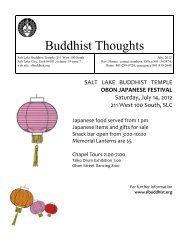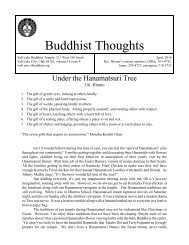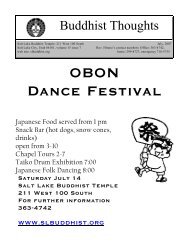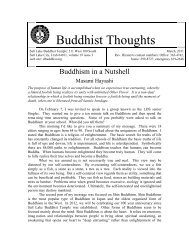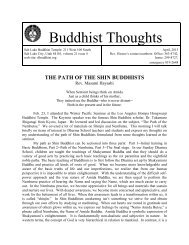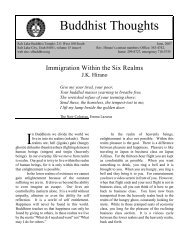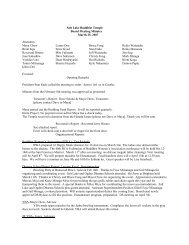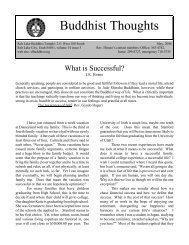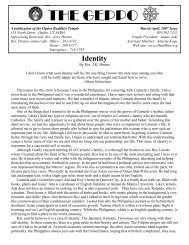Buddhist Thoughts - Salt Lake Buddhist Temple
Buddhist Thoughts - Salt Lake Buddhist Temple
Buddhist Thoughts - Salt Lake Buddhist Temple
Create successful ePaper yourself
Turn your PDF publications into a flip-book with our unique Google optimized e-Paper software.
THE VIEW FROM OUTSIDE IN:The 4 th Overseas District Representatives Seminar at theHongwanjiCarmela Javellana Hirano. M.D.“How was Japan? Did you have a good time?”Quite a few people came up to me shortly after Jerry and I came back October 17, 2009,asking about the trip. How can I summarize such an amazing, profound experience? How can Igive justice using words to what brings awe and spiritual inspiration to millions of Jodo Shinshu<strong>Buddhist</strong>s in Japan, and many more throughout the world? And how can I express gratitude toBCA and Nishi Hongwanji for allowing me this opportunity to see for myself the legacy ofShinran?The sights and sounds of Tokyo told me I was in a country of rich heritage and cuttingedge technology. Although I felt like an idiotic illiterate, not being able to read, say, orunderstand anything in Japanese, I sensed the considerate gentleness of the Japanese people, asthey spoke softly and melodiously, and bowed to each other and to us at every opportunity.Underneath this courteousness seemed a quiet determination to fulfill their day’s purpose, as theybustled on the busy narrow streets in their bicycles and efficient little cars, some parked cleverlyto fit in tidy little garages in front of nifty little houses. I savored tonkatsu, ramen, takoyaki, anddelicious sushi I’d never seen before with gusto. I especially loved the roofs – only in Japanhave I seen slate dressed in organic colors in gassho.After the bullet train showed me the countryside, Mount Fuji suspended in clouds, andlittle villages here and there, we came to Kyoto. It seemed unhurried and laid back, unlike thesuffocatingly crowded streets at Harajuku, famed in the US for its funky fashion in clothes andaccessories. Finally we came to Nishi Hongwanji – in contrast to the rest of the city, it wasimmense and overpowering. I was looking at the face of centuries of tradition, in it embeddedthe essence of Shinran and his work in teaching the dharma. We even got to meet the Gomonshuhimself, and the highest ranking officials of the organization, first during the opening service,then at a very nice dinner just for us “foreigners.” I hope it won’t be the last we discuss conceptslike “mottai nai” with Gomonshu-sama, thanks to the interpreting skills of Tanaka Sensei andArai Sensei.We had 3 days of touring Hongwanji, and studying and discussing issues regardingBuddhism in America and Canada, under the lively and provocative instruction of Rev. Dr. KenTanaka and Professor Toshikazu Arai. Arai Sensei taught the Essentials of Jodo Shinshu, theorganizational structure of Nishi Hongwanji, and the “Overseas” role of BCA and BCC. TanakaSensei lectured on the Growth of Buddhism in America. In my mind I concluded that BCA andBCC seem like toddlers trying keep going on a bike with no training wheels in the woods. Wediscussed “American Buddhism” and how its identity is not clearly understood, because peoplewho call themselves <strong>Buddhist</strong>s may not be <strong>Buddhist</strong> at all (as Tanaka Sensei referred to some as“Nightstand <strong>Buddhist</strong>s” and “sympathizers”), and people who do not identify themselves as<strong>Buddhist</strong> have <strong>Buddhist</strong> views about life and death. There are traditional Asian <strong>Buddhist</strong>s, newAsian American <strong>Buddhist</strong>s, and non-Asian <strong>Buddhist</strong> converts who either concentrate onmeditation and mindfulness or chanting.Questions were raised regarding the place of Jodo Shinshu Buddhism in America. It



